The 4K VR Displays Market is estimated to be valued at USD 1.6 billion in 2025 and is projected to reach USD 28.3 billion by 2035, registering a compound annual growth rate (CAGR) of 33.1% over the forecast period.
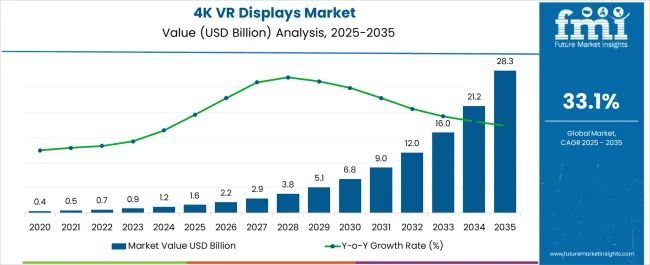
| Metric | Value |
|---|---|
| 4K VR Displays Market Estimated Value in (2025 E) | USD 1.6 billion |
| 4K VR Displays Market Forecast Value in (2035 F) | USD 28.3 billion |
| Forecast CAGR (2025 to 2035) | 33.1% |
The 4K VR displays market is gaining momentum due to rapid advancements in immersive technologies, increasing consumer adoption of high resolution content, and expanding applications across entertainment, healthcare, and education. Demand is being driven by the growing preference for lifelike visual experiences and reduced motion sickness in virtual environments.
Continuous innovation in display panels, miniaturization of components, and integration of OLED and micro LED technologies are enhancing performance standards. Additionally, the proliferation of 5G connectivity and cloud based content delivery is supporting seamless VR experiences, further driving adoption.
Regulatory focus on reducing latency and improving eye safety standards is also influencing market developments. The overall outlook remains promising as manufacturers prioritize high pixel density, low power consumption, and cost effective mass production to meet rising global demand for next generation VR solutions.
The market is segmented by Display Resolution and Application and region. By Display Resolution, the market is divided into Single Display Resolution, Dual Display Resolution, and Triple Display Resolution. In terms of Application, the market is classified into Smart phone, Smart watch, Smart TV, and Others. Regionally, the market is classified into North America, Latin America, Western Europe, Eastern Europe, Balkan & Baltic Countries, Russia & Belarus, Central Asia, East Asia, South Asia & Pacific, and the Middle East & Africa.
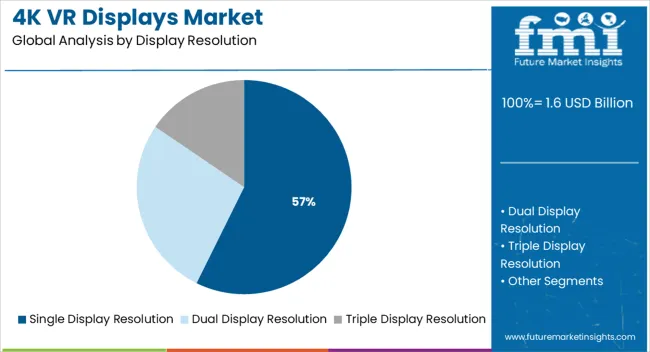
The single display resolution segment is projected to hold 57.30% of total revenue by 2025 within the display resolution category, making it the leading segment. Its growth is supported by widespread use in consumer VR devices that demand a balance between affordability, compact design, and immersive clarity.
Single display setups are favored for delivering consistent frame rates and manageable power requirements, making them accessible to a larger consumer base. Manufacturers have been investing in higher pixel density and improved refresh rates to optimize visual performance without significantly increasing costs.
The ability to integrate seamlessly into lightweight and portable VR headsets has further strengthened the dominance of single display resolution in the market.
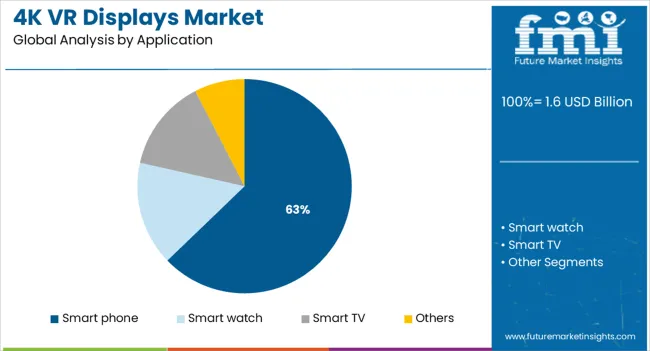
The smart phone application segment is expected to contribute 62.80% of total market revenue by 2025 within the application category, positioning it as the leading area of adoption. Growth is being fueled by increasing availability of VR compatible smartphones, widespread internet penetration, and consumer demand for on the go immersive experiences.
Smartphones offer a cost effective entry point into VR, making the technology more accessible to mass markets. The rapid evolution of mobile processors, high refresh rate displays, and stronger graphics capabilities have significantly enhanced VR performance on handheld devices.
As 5G deployment expands and mobile ecosystems mature, smartphones are expected to remain the largest driver of VR adoption, consolidating their share as the leading application in the 4K VR displays market.
The market for 4K VR displays is currently a niche market and is expected to grow in the future as technology advances and the demand for higher resolution VR experiences increases.
The growth of 4K VR displays market is attributed to factors such as the increasing adoption of VR technology in various industries, the growing popularity of gaming and video content, and the availability of more affordable VR hardware.
Additionally, the increasing demand for high-quality VR experiences in industries such as healthcare, education, and real estate is also expected to drive the market for 4K VR displays.
The high cost of 4K VR displays can make them prohibitively expensive for many consumers that may impede the growth of this market.
Additionally, the limited availability of 4K VR content may also hinder market growth. Other constraints include the need for high-performance computing hardware to support 4K VR displays, as well as the lack of standardization in the VR industry.
North America had the largest market share for 4K VR displays solutions market for the year 2025, with a market share of 28.2%. While South Asia and Pacific is expected to be the fastest growing region with a CAGR of 29.1%
The gaming and entertainment industry in North America is well-developed, and the region has a strong presence of tech giants such as Facebook, Google and Microsoft, which are actively promoting the development and use of VR technology.

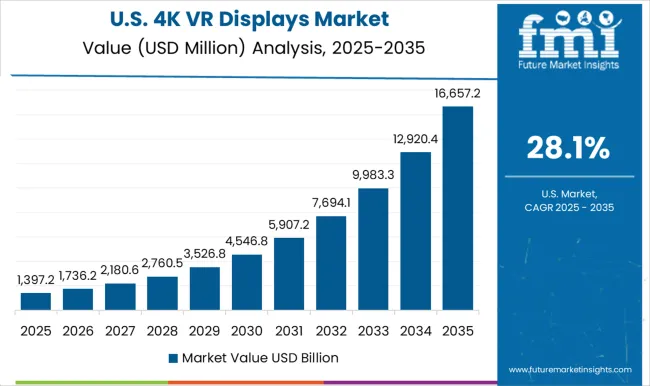
There is huge number of virtual reality technology users present in the United States and number is also increasing day by day. People in USA has a high purchasing power and a large number of tech-savvy consumers, which increases the demand for high-end VR displays such as 4K VR displays.
The 4K VR displays market in the United States is expected to grow significantly in the coming years, owing to advancements in VR technology, increased use of VR in various industries, and rising demand for immersive gaming and entertainment experiences, all of which will drive the market in the coming years. The USA has highest market of 20.1% 4K VR displays market
China is a significant player in the technology sector, China is home to a number of businesses engaged in the creation and development of virtual reality technology, including 4K VR displays.
The Chinese government has also made investments in the VR market in an effort to dominate the market of 4K VR Display worldwide. The Chinese market is a large and rapidly growing market for VR technology. China represents a significant opportunity for manufacturers and developers of VR technology.
However, the VR market in China is also highly competitive, with many domestic companies vying for market share. China Holds Highest CAGR of 28.1% in 4K VR displays market.
The Indian market for 4K VR displays is relatively small, but it is expected to grow in the coming years. The increasing popularity of virtual reality and the advancements in technology are driving the demand for high-resolution VR displays.
Additionally, the Indian government's push for digitalization and the growing gaming industry are also expected to drive the growth of the 4K VR displays market in India.
There are several reasons why the smart TV application is growing in the 4K VR display market. One reason is that 4K resolution provides a clearer and more detailed picture, which enhances the overall viewing experience.
Additionally, the use of VR technology in smart TVs allows for a more immersive viewing experience, as it simulates a more realistic environment. As a result, more and more consumers are opting for smart TVs with 4K VR displays. Furthermore, the increase in streaming services and the availability of 4K content is also driving the growth of this market.
The 4K VR (virtual reality) display market has a high market share for triple display resolution because it offers a more immersive and realistic experience for users. The high resolution allows for more detailed and lifelike images and the virtual reality aspect allows for a greater sense of presence and immersion in the content.
Additionally, advancements in technology have made 4K VR displays more affordable and accessible, contributing to their growing popularity and market share.
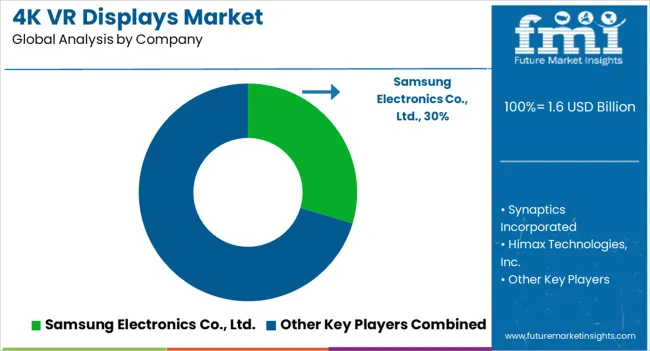
The 4K VR display market is extremely competitive, with several major players. These market leaders are widening their customer base to include customers from other countries. Major players are focusing mainly on the new product development and designing in the new triple display and 4D display to provide top-notch viewing experience to users.
| Attribute | Details |
|---|---|
| Market value in 2025 | USD 1.6 billion |
| Market CAGR 2025 to 2035 | 14.9% |
| Share of top 5 players | Around 35% |
| Forecast Period | 2025 to 2035 |
| Historical Data Available for | 2020 to 2025 |
| Market Analysis | USD Billion for Value |
| Key Regions Covered | North America; Latin America; Europe; South Asia & Pacific; East Asia and the Middle East & Africa |
| Key Countries Covered | USA, Canada, Germany, UK, France, Italy, Spain, Russia, China, Japan, South Korea, India, Australia & New Zealand, GCC Countries, Turkey and South Africa |
| Key Segments Covered | Display Resolution, Application, Region |
| Key Companies Profiled | Samsung Electronics Co., Ltd.; Synaptics Incorporated; Himax Technologies, Inc.; Raydium Semiconductor Corporation; New Vision Display, Inc.; Varjo; Sony; DPVR |
| Report Coverage | Market Forecast, Company Share Analysis, Competition Intelligence, DROT Analysis, Market Dynamics and Challenges, and Strategic Growth Initiatives |
| Customization & Pricing | Available upon Request |
The global 4k vr displays market is estimated to be valued at USD 1.6 billion in 2025.
The market size for the 4k vr displays market is projected to reach USD 28.3 billion by 2035.
The 4k vr displays market is expected to grow at a 33.1% CAGR between 2025 and 2035.
The key product types in 4k vr displays market are single display resolution, dual display resolution and triple display resolution.
In terms of application, smart phone segment to command 62.8% share in the 4k vr displays market in 2025.






Full Research Suite comprises of:
Market outlook & trends analysis
Interviews & case studies
Strategic recommendations
Vendor profiles & capabilities analysis
5-year forecasts
8 regions and 60+ country-level data splits
Market segment data splits
12 months of continuous data updates
DELIVERED AS:
PDF EXCEL ONLINE
4K Drawing Tablet with Screen Market Size and Share Forecast Outlook 2025 to 2035
4K Technology Market Size and Share Forecast Outlook 2025 to 2035
4K Satellite Broadcasting Market Size and Share Forecast Outlook 2025 to 2035
4K Display Resolution Market Size and Share Forecast Outlook 2025 to 2035
Ultra-High Definition (UHD) Panel (4K) Market Size and Share Forecast Outlook 2025 to 2035
VRLA Battery Market Size and Share Forecast Outlook 2025 to 2035
VRLA SLI Battery Market Size and Share Forecast Outlook 2025 to 2035
VR Headsets Market Size and Share Forecast Outlook 2025 to 2035
VRF Systems Market Growth - Trends & Forecast 2025 to 2035
VR Stroke Rehabilitation Market Insights – Growth & Trends 2023-2033
VR HMD Shipment Market
AR VR Software Market Trends - Growth & Forecast 2025 to 2035
AR and VR in Training Market Size and Share Forecast Outlook 2025 to 2035
Stationary VRLA Battery Market Size and Share Forecast Outlook 2025 to 2035
Displays Market Insights – Growth, Demand & Forecast 2025 to 2035
LED Displays, Lighting and Fixtures Market Size and Share Forecast Outlook 2025 to 2035
Floor Displays Market Growth from 2025 to 2035
Pallet Displays Market Size and Share Forecast Outlook 2025 to 2035
Retail Displays Market Size and Share Forecast Outlook 2025 to 2035
Military Displays Market Size and Share Forecast Outlook 2025 to 2035

Thank you!
You will receive an email from our Business Development Manager. Please be sure to check your SPAM/JUNK folder too.
Chat With
MaRIA